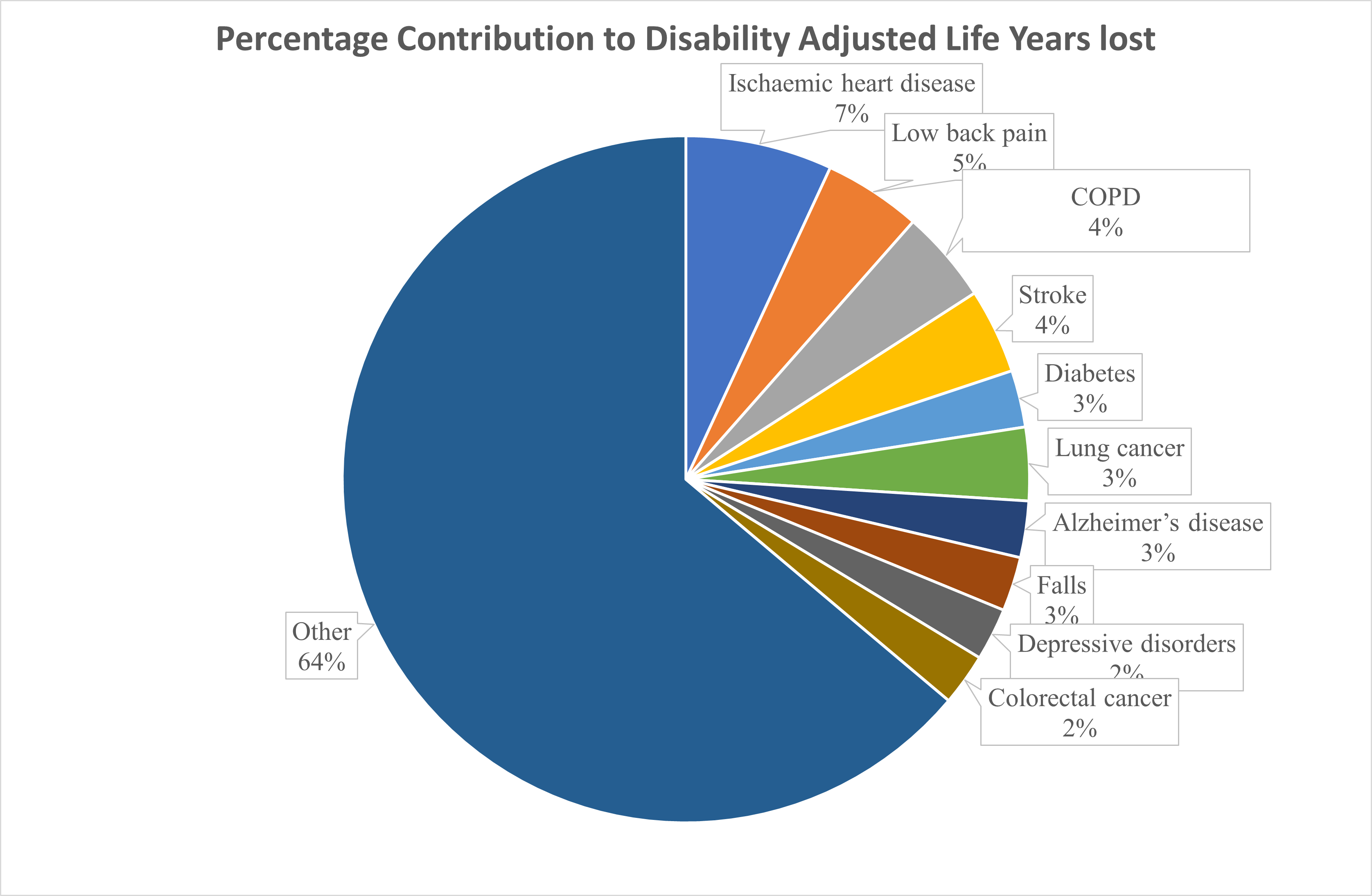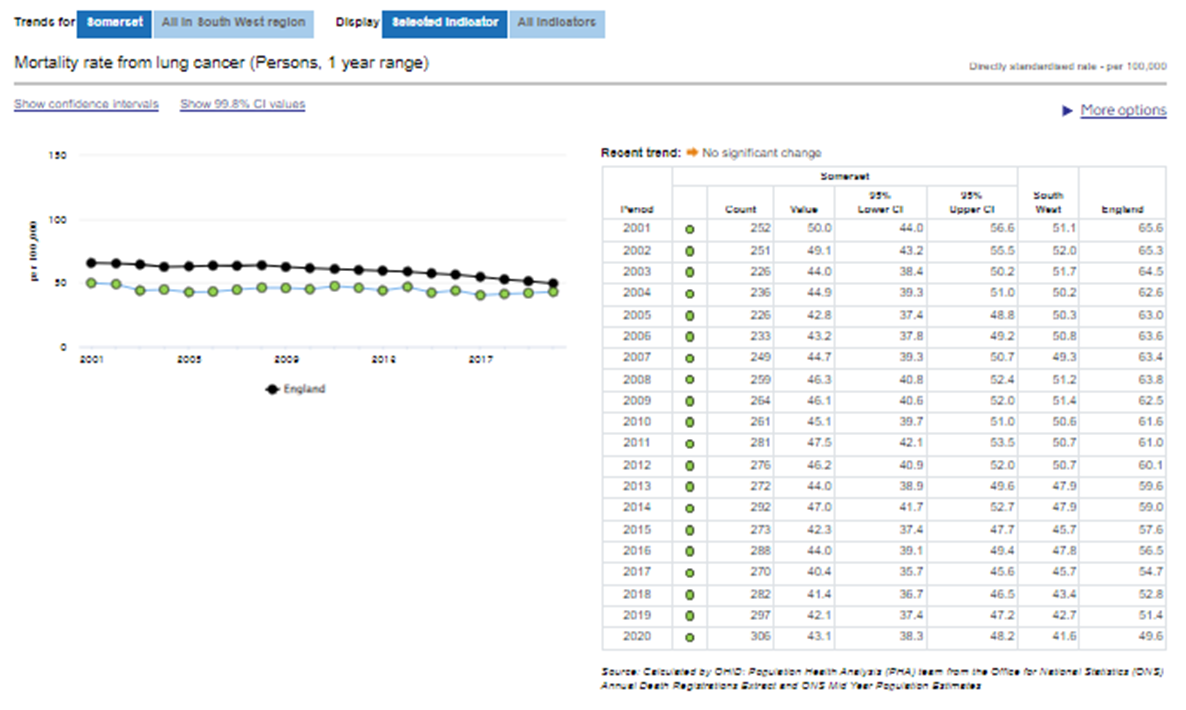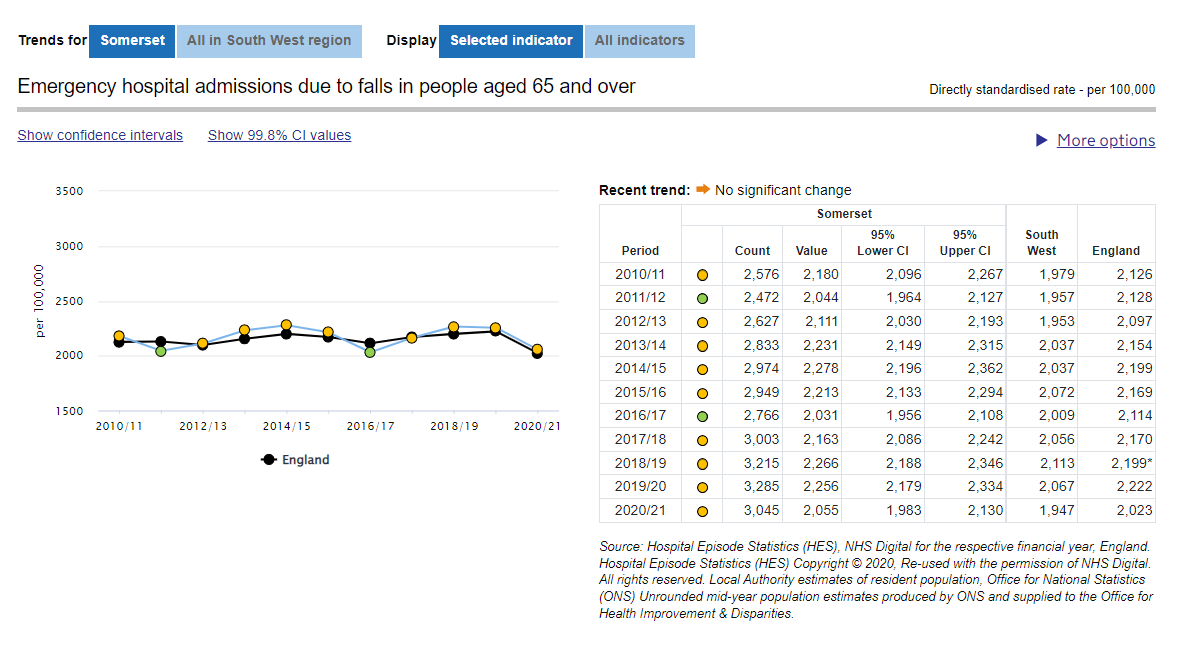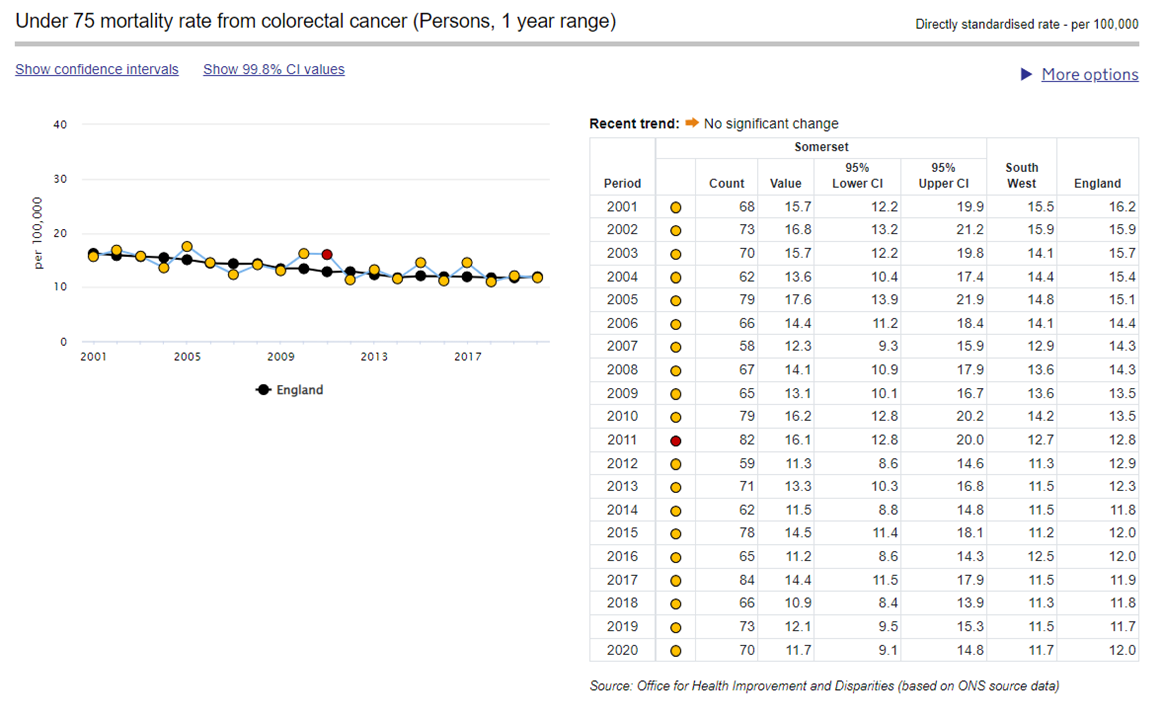Global Burden of Disease
Health priorities for Somerset are derived from the Global Burden of Disease, which compares loss to population health from all diseases and risk factors. We have looked at an outcome called a DALY – Disability Adjusted Life Year. This enables us to measure the impact of conditions in both shortening life and reducing years of life lived in full health, recognizing that our key goal is to increase the years of life lived in good health and reduce early deaths – not just try to extend life expectancy. The main causes of loss of DALYs for our whole population are shown below. Whilst this is a consistent set of figures, it should be remembered that apparent priority can be affected by the classification, such as in separating different forms of cancer. Mental health and substance abuse, considered together, have been estimated to contribute over 21% of the total burden of disease.

Ischaemic Heart Disease
Circulatory diseases such as ischaemic heart disease cause more deaths in Somerset than any other condition type, and contributes 7.19% to the Disability Adjusted Life Years lost in the county.
The prevalence of cardiovascular disease increases significantly after the age of 40 years. The NHS Health Checks programme in Somerset is a key priority as it focuses on raising awareness of the risk factors for cardiovascular disease and offers individuals support to reduce their future risk. During 2018/19, 82% of the annual target population were invited to a check and 27% received a check. In 2019/20 the proportion remained at 27%; this service has been significantly disrupted by Covid-19 precautions since then.
Somerset’s mortality rates have declined at a slowing pace, but are consistently lower than the England average.
Improvements can be made by addressing primary risk factors such as smoking, obesity, lack of physical activity and excess alcohol consumption alongside secondary prevention to detect and treat high blood pressure, high cholesterol, hyperglycaemia, atrial fibrillation and familial hypercholesterolemia. This can be delivered through NHS Healthchecks and detection and management of high risk conditions, supported by development of digital and remote provision of lifestyle services and monitoring of conditions such as high blood pressure.
Key indicator – Under 75 mortality rates
Data from before 2021 show trends, but cannot be compared directly to 2021 figures.

More data from OHID Fingertips and Cardio-vascular Disease Profiles
Low Back Pain
Low back pain contributes to 4.79% of the Disability Adjusted Life Years lost in Somerset. This is particularly because of the length of time that people can suffer from such pain, with its effects on physical activity, rather than being a major cause of death in its own right. Somerset tends to have a higher proportion of the population with the condition, which reflects the relatively elderly population structure in the county. Low back pain is an important type of musculoskeletal (MSK) condition.
Key indicator: percentage reporting long-term musculoskeletal (MSK) problem
Chronic Obstructive Pulmonary Disease (COPD)
hronic Obstructive Pulmonary Disease (COPD) includes emphysema and chronic bronchitis, and is one of the most common forms of respiratory diseases and usually affects those over the age of 35. Somerset’s emergency hospital admission rate for COPD in adults tends to be significantly lower than the England value, but still contributes 4.56% of all Disability Adjusted Life Years lost in the county.
Respiratory infection is associated with social inequalities in all age groups and particularly in children. In Somerset the population in the lower quintiles of deprivation have a greater frequency of emergency admission to hospital. Emergency admissions for children due to lower respiratory infections are decreasing in Somerset.
Immunisations are available to protect against certain respiratory infections. Uptake is especially important for vulnerable groups such as older people and those with compromised immune systems. In Somerset, ‘flu and pneumococcal vaccination rates tend to be higher than the national average; however there are still many people who could benefit by receiving protection through vaccination. Driving up uptake of Covid-19, flu and pneumonia vaccines to reduce infective exacerbations of COPD, and emergency hospital admissions due to those exacerbations, is part of the Core20PLUS5 programme to reduce healthcare inequalities.
Key indicator: Emergency Hospital Admissions for COPD (35+)
Data from before 2019/20 show trends, but cannot be compared directly to 2021/22 figures.

Compare with neighbours Public health profiles – OHID (phe.org.uk)
Stroke
Stroke is, like ischaemic heart disease, a circulatory disease that contributes significantly to the loss of Disability Adjusted Life Years in Somerset. Rates in Somerset tend to be higher than the England average, and have shown a long-term increase. Both of these can largely be attributed to the elderly population structure.
Key indicator
Diabetes
Diabetes is a common life-long health condition. There are 3.8 million people diagnosed with diabetes in the UK and an estimated 850,000 people who have the condition but don’t know it. Diabetes significantly increases the risks of heart attacks, strokes, blindness, kidney failure and amputation and reduces life expectancy by more than fifteen years for someone with Type 1 diabetes and up to ten years for someone with Type 2 diabetes (source: YHPHO).
Risk factors associated with diabetes include behavioural factors such as lack of physical activity, diet and smoking. Age is also a key factor in diabetes prevalence. Type 1 diabetes tends to be diagnosed in childhood but the prevalence of Type 2 diabetes increases steadily after the age of 45 years. Type 2 diabetes prevalence is higher in areas experiencing deprivation. People living in the 20% most deprived neighbourhoods in England are 56% more likely to have diabetes than those living in the least deprived areas. It is known that people from Asian and Black ethnic groups are more likely to have diabetes and tend to develop the condition at younger ages (source: Yorkshire and Humber Public Health Observatory, YHPHO). In addition to direct health costs, there is a considerable impact on social care expenditure as diabetes complications are estimated to increase costs four-fold.
Key indicator: Diabetes QOF Prevalence (17+ yrs)
Lung Cancer
Cancer of the lung is one of the most prevalent malignancies. Incidence and mortality rates tend to be lower in Somerset than for England. Although not the only cause, lung cancer is strongly linked to smoking. Early cancer diagnosis – 75% to be diagnosed at stage one or two by 2028 – is part of the Core20PLUS5 programme to reduce health inequalities.
As with all cancer, early identification is strongly linked to better outcomes. For cancers such as breast and bowel, screening programmes can help provide that early diagnosis; uptake should be particularly encouraged in more deprived groups, where it has been low in the past. Very brief advice, given by health professionals such as GPs, can be very effective in activating a patient to take action to modify their unhealthy lifestyle behaviours.
Key indicator: Mortality Rate from Lung Cancer, all ages (Persons)
Data from before 2021 show trends, but cannot be compared directly to 2021 figures.

Alzheimer’s disease
Alzheimer’s is the most common form of dementia, which describes a set of symptoms which include loss of memory, mood changes and problems with communication and reasoning. It is progressive, and patients may have the condition for years. It may be a direct cause of death, or frequently a contributing factor; both are included in the indicator.
Key indicator: Directly Standardised Rate of Mortality People with Dementia (aged 65yrs and over)

Falls
Falls are the leading cause of mortality due to injury. As people age, they have an increased risk of falling – an estimated 30% of those aged 65 and up to 50% of those aged 80 fall each year. A fall can lead to complications arising from being unable to get up, a loss of confidence and independence, greater social isolation and a reduction in physical activity. Rates in Somerset have been generally similar to the England average.
Key indicator: Emergency Admissions due to Falls in People aged 65 and Over
Data from before 2021/22 show trends, but cannot be compared directly to 2021 figures

More data from OHID Fingertips and Falls Health Needs Assessment
Depressive disorders
Depression is, along with anxiety, one of the most frequent conditions of mental ill-health.
Early childhood is a time of particular importance, as children’s brains are quite literally shaped by their experiences. Abuse, insecurity and anxiety in the early years can be hugely detrimental to a child’s development. There is good evidence that investment in early years, preventing exposure to violence and abuse and investment in high quality parenting programmes and conduct disorder interventions can be highly effective in protecting children from the lifelong impacts of poor mental health.
Risk factors for poor mental health in adulthood include unemployment, low income, debt, violence, stressful life events, inadequate housing, fuel poverty and other adversity such as serving in combat. Risk factors disproportionately affect the mental health of people from marginalised groups. Targeted intervention for groups at higher risk of mental illness can prevent a widening of inequalities in comparison with the general population. Protective factors include stable housing, strong, positive social networks and support; access to green space; feeling safe and having a good sense of meaning and purpose.
Severe mental illness is part of the Core20PLUS5 programme, with annual health checks for 60% of people in this group being part of the plan to reduce health inequalities adversely affecting people with the condition.
Key indicator: Depression QOF Prevalence
Colorectal Cancer
Colorectal, or bowel, cancer is one of the most common types of cancer diagnosed in the UK. Most people diagnosed with it are over the age of 60. As well as age and family history, the avoidable risk is higher among those with a diet high in red or processed meat and low in fibre, the overweight, the physically inactive, those who smoke, and drink alcohol. Early cancer diagnosis – 75% to be diagnosed at stage one or two by 2028 – is part of the Core20PLUS5 programme to reduce health inequalities.
Rates in Somerset are broadly similar to the England average.
Key indicator: Under 75 Mortality Rate from Colorectal Cancer (persons, 1 year range)
Data from before 2021 show trends, but cannot be compared directly to 2021 figures

More data from OHID Fingertips
Next: Ill health risk factors
